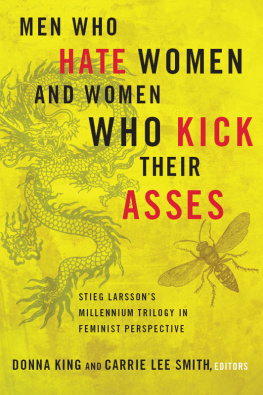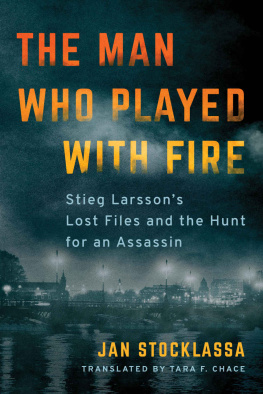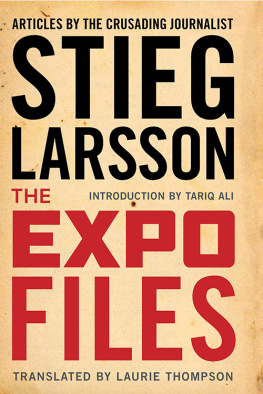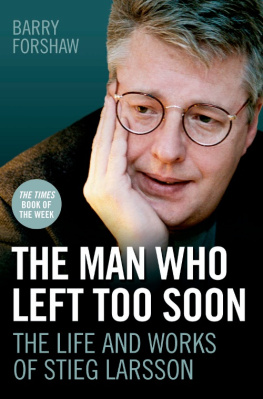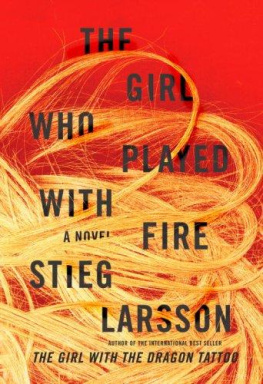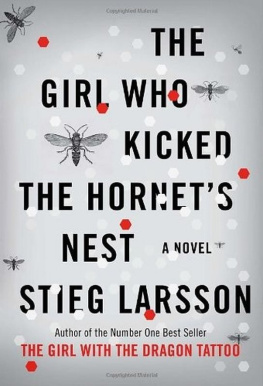STIEG LARSSON,
MY FRIEND
KURDO BAKSI
STIEG LARSSON,
MY FRIEND
Translated from the Swedish by Laurie Thompson

VIKING CANADA
Published by the Penguin Group
Penguin Group (Canada), 90 Eglinton Avenue East, Suite 700, Toronto, Ontario, Canada M4P 2Y3
(a division of Pearson Canada Inc.)
Penguin Group (USA) Inc., 375 Hudson Street, New York, New York 10014, U.S.A.
Penguin Books Ltd, 80 Strand, London WC2R 0RL, England
Penguin Ireland, 25 St Stephens Green, Dublin 2, Ireland (a division of Penguin Books Ltd)
Penguin Group (Australia), 250 Camberwell Road, Camberwell, Victoria 3124, Australia
(a division of Pearson Australia Group Pty Ltd)
Penguin Books India Pvt Ltd, 11 Community Centre, Panchsheel Park, New Delhi 110 017, India
Penguin Group (NZ), 67 Apollo Drive, Rosedale, North Shore 0745, Auckland, New Zealand
(a division of Pearson New Zealand Ltd)
Penguin Books (South Africa) (Pty) Ltd, 24 Sturdee Avenue, Rosebank,
Johannesburg 2196, South Africa
Penguin Books Ltd, Registered Offices: 80 Strand, London WC2R 0RL, England
Published in Viking Canada hardcover by Penguin Group (Canada),
a division of Pearson Canada Inc., 2010.
Simultaneously published in Sweden as Min vn Stieg Larsson by Norstedts, Stockholm,
and in Great Britain as Stieg Larsson, My Friend by MacLehose Press,
an imprint of Quercus, 21 Bloomsbury Square, London WC1A 2NS.
1 2 3 4 5 6 7 8 9 10
Copyright Kurdo Baksi, 2010
English translation copyright Laurie Thompson, 2010
Late Fragment from All of Us: Collected Poems by Raymond Carver, published by
The Harvill Press and reprinted by permission of The Random House Group Ltd.
All rights reserved. Without limiting the rights under copyright reserved above,
no part of this publication may be reproduced, stored in or introduced into a retrieval system,
or transmitted in any form or by any means (electronic, mechanical, photocopying, recording
or otherwise), without the prior written permission of both the copyright owner and the above
publisher of this book.
Manufactured in the U.S.A.
Library and Archives Canada Cataloguing in Publication data available upon request to publisher.
ISBN: 978-0-670-06536-3
British Library Cataloguing in Publication data available
Visit the Penguin Group (Canada) website at www.penguin.ca
Special and corporate bulk purchase rates available; please see
www.penguin.ca/corporatesales or call 1-800-810-3104, ext. 2477 or 2474
The end and a beginning
Stieg Larssons funeral took place on Friday, 10 December, 2004, in the Chapel of the Holy Cross at Forest Cemetery in southern Stockholm. The chapel was packed with relatives, friends and acquaintances. We led past the cofn to pay our respects. Most of us whispered a nal message as we walked slowly past the bier.
On the back of the order of service was a poem by Raymond Carver, Late Fragment, from the collection he completed shortly before his death:
And did you get what
you wanted from this life, even so?
I did.
And what did you want?
To call myself beloved, to feel myself
beloved on the earth.
When Carver was asked how he wanted to be remembered, he replied, I can think of nothing better than to have been called an author. Not many of the congregation in the chapel that afternoon would have realized that the same applied to Stieg. That he would be remembered as the author of one of the biggest, least expected publishing successes of modern times. For most of us he was a tireless hero in the ght against racism there was no battle for democracy and equality that he was unwilling to take part in. He was aware that there was a high price attached to doing so, but it was a price he was prepared to pay. The constant threats, the lack of nancial resources and the sleepless nights. It was a struggle that shaped his whole life.
But Stieg became an author thanks to the capriciousness of life and death only when he was no longer with us.
That afternoon we attended an uplifting memorial ceremony at the Workers Educational Association in Stockholm, a venue at which Stieg had been keen to lecture ever since the publication of his rst book, Extremhgern (The Extreme Right), in the spring of 1991. Tributes came thick and fast, delivered by, among others, his father, Erland Larsson, his brother, Joakim Larsson, his partner, Eva Gabrielsson, the publisher of Expo magazine, Robert Aschberg, the publisher-in-chief at Norstedts, Svante Weyler, the historian Helne Lw, Graeme Atkinson from the British magazine Searchlight and Gran Eriksson, the head of the Swedish W.E.A. I was master of ceremonies.
After the memorial ceremony we repaired to Sdra Teatern, the theatre in the Sder district of southern Stockholm, a favourite haunt of Stiegs in his last years, for a funeral feast. It was icy cold on the terrace; the December chill froze us through and through. We shared our grief family, friends, acquaintances and the entire staff of Expo. It was late at night before we broke up. We trudged home, each of us with our own memories of Stieg etched indelibly on our minds.
That was when the really difcult part began. Mourning in private.
Farewell is a hard word to dene. Who is saying farewell to whom? The one who leaves or the one who stays behind? I keep coming back to that question over and over again. Of course I have lost a lot of friends and acquaintances over the years, but Stieg was my rst really close friend to die. I set myself very high standards while grieving, but found myself groping around helplessly even so. I didnt know how to mourn with sufcient intensity.
After a while I realized that my memory was failing me. I forgot the names of people, lost my sense of direction, became anxious and depressed. But all the while the same message was pounding away at the back of my mind: I had to be strong. Stiegs partner, Eva, and the young members of the Expo staff needed me. I couldnt let them down now. I must not burst into tears in front of friends and acquaintances. I had learned a lesson from my time in the mountains of Kurdistan during the freedom struggle there: there is a time to weep, and a time to maintain a stiff upper lip and do whatever needs to be done.
I realized that I had to compromise. For a long time I avoided Expo and the places where Stieg and I used to meet: Il Caff, Caf Anna, Caf Latte, the Indian restaurants on Kungsholmen and McDonalds in St Eriksgatan. Eventually I began to behave in exactly the opposite way. I wore black and made a point of going to the places I used to frequent with Stieg. It wasnt that I imagined we were sitting there together. It was rather a case of going there in order to come to terms with my own situation, irrespective of whether I actually wanted a meal.
Months passed. Eventually the day came when the rst reviews of Mn som hatar kvinnor (Men Who Hate Women, in English called The Girl with the Dragon Tattoo) were published. I eagerly devoured every word and was overwhelmed by a strange feeling: I took everything that was said about the book personally. I began to regard myself as a sort of stand-in for Stieg. The reviews were almost exclusively positive, which pleased and distressed me at the same time. I was pleased by the thought that the books were going to be read by a lot of people, distressed because Stieg wouldnt be able to experience this for himself.
Eventually the rst anniversary of that awful day came round. Rain pelted remorselessly against the windowpanes during the night of 8 November. My flat was only a stones throw from Stiegs house. I was overcome once more by a tidal wave of sorrow and longed to be able to talk to him. I wished I could tell him that I was in love with a woman I knew he had met at one of the parties we had attended together. But there was only silence. I sat there, staring at the black and white tie Stieg had worn the last day of his life, the one Eva had given me as a keepsake. He should be close by, I thought, but he felt so dreadfully far away.
Next page


